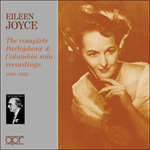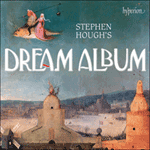
Welcome to Hyperion Records, a British classical label devoted to presenting high-quality recordings of music of all styles and from all periods from the twelfth century to the twenty-first.
Hyperion offers both CDs, and downloads in a number of formats. The site is also available in several languages.
Please use the dropdown buttons to set your preferred options, or use the checkbox to accept the defaults.

can be considered as a sonata in four movements: the first Rhapsody is the first movement, because it has a simpler form; the second Rhapsody replaces the slow movement; the third corresponds to a scherzo of a sonata; the last Rhapsody, an elaboration of the Gregorian chant ‘Dies Irae’, includes the themes of the former three Rhapsodies. I did not call the work ‘sonata’, because its structure is somewhat looser and each piece can be performed separately.
While some listeners have identified a Hungarian flavour to the work, especially in the Rhapsody in F sharp minor, Dohnányi eschewed such attributions. He insisted that the individual movements ‘are not rhapsodies in the sense of the Hungarian Rhapsodies by Liszt, in which Hungarian folksongs are elaborated. My themes are all original, and when people find that their style is Hungarian, it is because I am Hungarian.’
from notes by James A Grymes © 2012
peut être considérée comme une sonate en quatre mouvements: la première Rhapsodie est le premier mouvement, de par sa forme simplifiée; la deuxième remplace le mouvement lent; la troisième correspond à un scherzo de sonate; la dernière, qui développe le «Dies Irae» grégorien, inclut les thèmes des trois autres. Je n’ai pas appelé cette œuvre «sonate» parce que sa structure est un peu plus distendue et que chaque morceau peut être joué séparément.
Certains auditeurs ont trouvé une saveur hongroise à cette œuvre, surtout à la Rhapsodie en fa dièse mineur, mais cette idée, Dohnányi la fuyait. Les mouvements, insista-t-il, «ne sont pas des rhapsodies au sens des Rhapsodies hongroises de Liszt, où des chants folkloriques hongrois sont développés. Mes thèmes à moi sont tous originaux et si les gens leur trouvent un style hongrois, c’est parce que je suis Hongrois».
extrait des notes rédigées par James A Grymes © 2012
Français: Hypérion
als viersätzige Sonate betrachten könne: die erste Rhapsodie auf Grund ihrer einfacheren Form ist der erste Satz; die zweite Rhapsodie steht an der Stelle des langsamen Satzes; die dritte entspricht einem Sonatenscherzo; die letzte Rhapsodie, eine Ausführung des Gregorianischen Hymnus „Dies Irae“, enthält die Themen der vorigen drei Rhapsodien. Ich habe das Werk nicht als „Sonate“ bezeichnet, weil es in der Struktur etwas freier ist und jedes Stück für sich gespielt werden kann.
Einige Hörer haben an dem Werk zwar ungarische Anklänge ausgemacht, besonders in der fis-Moll-Rhapsodie; doch scheute Dohnányi derartige Zuschreibungen. Er beharrte darauf, dass die einzelnen Sätze „keine Rhapsodien wie die Ungarischen Rhapsodien von Liszt seien, der darin ungarische Volkslieder verarbeitet hat. Meine Themen sind alle original, und wenn man ihren Stil als ungarisch empfindet, so deshalb, weil ich Ungar bin.“
aus dem Begleittext von James A Grymes © 2012
Deutsch: Christiane Frobenius
 Eileen Joyce - The complete Parlophone & Columbia solo recordings Eileen Joyce - The complete Parlophone & Columbia solo recordings‘Listening to Joyce is strangely addictive. One cannot wait, as it were, to read the next chapter. She shares with Kreisler and Tauber the same unteac ... ‘The quality that comes across in these performances is the sheer joy of playing. Joyce possessed a formidable technique and an interpretative mind th ...» More |
 Stephen Hough's Dream Album Stephen Hough's Dream AlbumA wistful, whimsical side of Stephen Hough’s prodigious musicality is on display in this delectable assortment of pianistic treats, from the lighter works of Dvořák and Elgar, to Moscow nights, old Vienna, and far beyond.» More |

